Top AI Image Generators
In recent years, artificial intelligence has quietly—yet profoundly—reshaped the way we create visual content. What once required hours of sketching or expensive photo shoots can now come to life with just a few words. From breathtaking fantasy worlds to lifelike product prototypes, AI image generators are no longer just tools—they’re becoming creative companions, empowering artists, marketers, educators, and dreamers alike
At the heart of this visual revolution are three standout platforms: Midjourney, DALL·E, and Stable Diffusion. Each of these tools brings something different to the table—like unique personalities with their own quirks, talents, and styles. Whether you’re an experienced designer seeking new inspiration, a content creator trying to level up your visuals, or just someone curious about the future of art and technology, understanding these tools can help you unlock a new world of creative possibility.
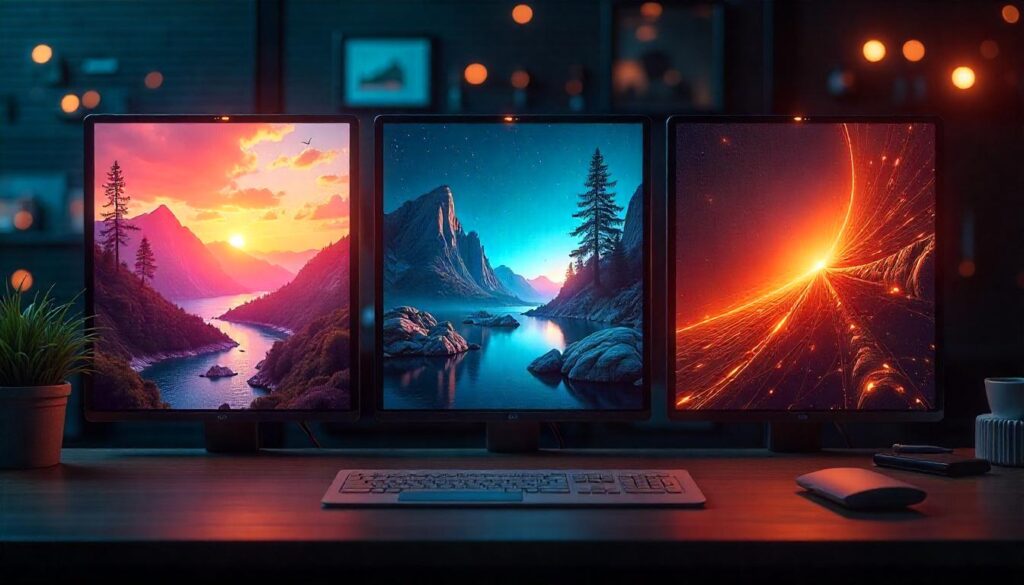
This article is your guide through that world. We’ll walk you through the strengths, limitations, and best use cases for each of these leading AI image generators. We won’t name a single “best” one—because the right choice depends on your needs, your goals, and the kind of visual story you want to tell. Instead, our aim is to help you discover which tool feels like the right fit for you.
The field of AI-generated imagery is evolving rapidly. Staying informed is more than a tech-savvy move—it’s a way to stay connected to the future of creativity. So let’s dive into the landscape of 2025 and explore how Midjourney, DALL·E, and Stable Diffusion are reshaping the way we imagine, design, and express ourselves.
Table of Contents
What Are AI Image Generators?
At their core, AI image generators are a magical blend of language and vision. Powered by sophisticated machine learning—particularly deep learning—these tools can transform simple text prompts into stunning visual art. Imagine typing a sentence like “a lighthouse floating in the sky, painted in Van Gogh’s style,” and seeing it materialize before your eyes. That’s the power of generative AI.
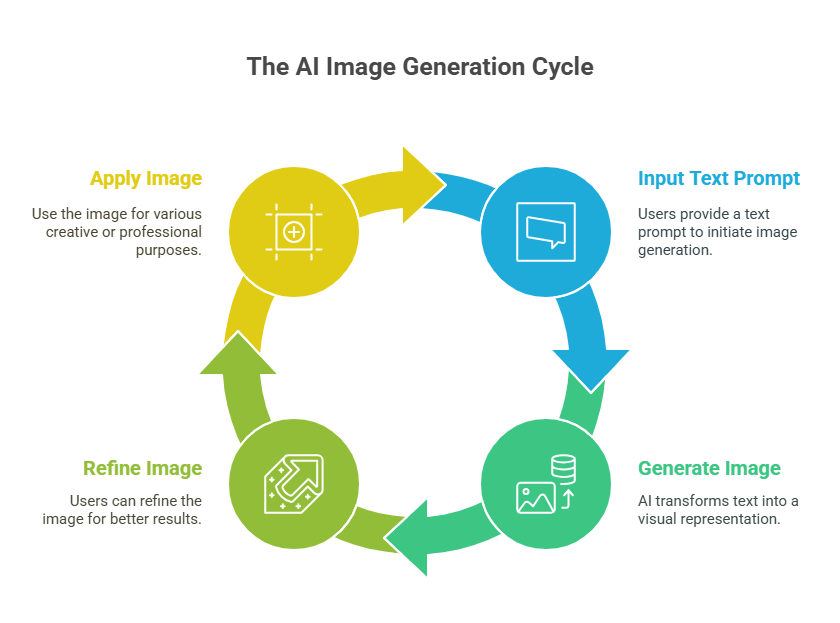
Most of these platforms are built on what’s called generative diffusion models. These models start with a canvas of random noise and gradually “paint” their way to an image that reflects your prompt. It’s like watching a Polaroid picture develop—except the image is something no one has ever seen before.
Some platforms, like Stable Diffusion, offer more hands-on control for those who like to tinker. Others, like DALL·E, are built for simplicity and speed, making them perfect for casual creators or those working on tight deadlines. Meanwhile, Midjourney leans into artistry, creating ethereal, painterly images that often feel like they came from a dream.
AI in Digital Marketing: The Game-Changer You Can’t Ignore
The ways people are using these tools are just as imaginative and varied as the images they create. Artists use AI to brainstorm ideas or enhance their portfolios. Educators use it to make lessons more engaging. Marketing teams are creating eye-catching visuals without breaking the bank. And then there are the everyday users—experimenting, having fun, and tapping into their own creativity in ways they never thought possible.
Overview of the Top 3 AI Image Generators
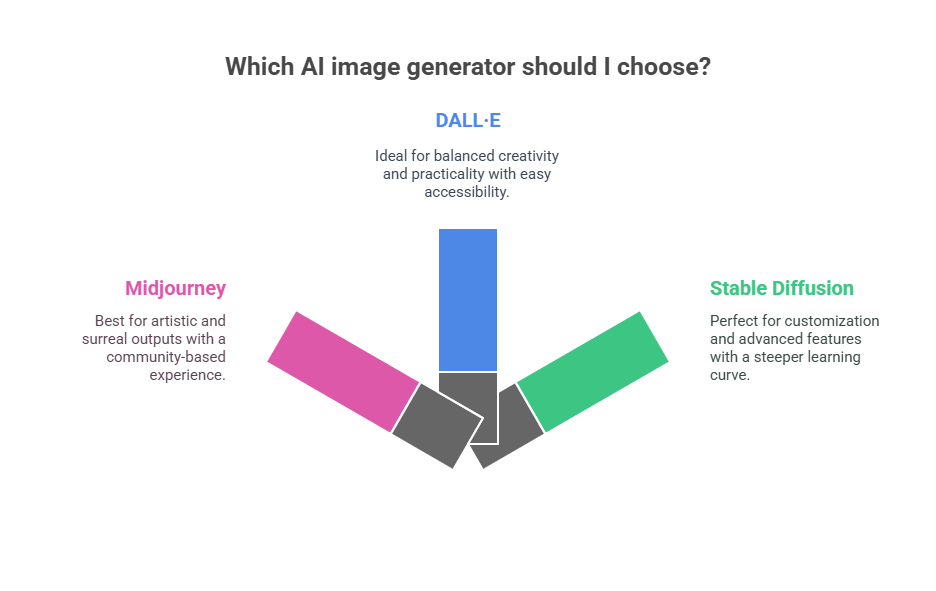
1. Midjourney
Midjourney feels like stepping into an artist’s dream. Known for its deeply stylized, often surreal outputs, it produces images that are rich, textured, and full of emotion. Developed by an independent research lab, it operates through Discord—a community-based platform that adds a collaborative, almost social experience to the creative process.
This can be thrilling for some users, who enjoy sharing prompts, learning from others, and exploring a shared artistic space. But for newcomers or those used to traditional interfaces, it may feel a bit intimidating at first.
Midjourney’s true strength lies in its ability to generate bold, imaginative visuals with very little guidance. It’s particularly beloved by illustrators, storytellers, and content creators who want their visuals to stand out with a unique flair. While it doesn’t offer as much technical precision or editing control as other tools, it more than makes up for it with sheer artistic soul.
2. DALL·E
Developed by OpenAI, DALL·E strikes a beautiful balance between creativity and practicality. Its integration into platforms like ChatGPT and Microsoft Bing makes it incredibly accessible—even for those who’ve never used an AI image tool before. The interface is intuitive, the results are reliable, and the image quality is strong across a wide range of styles.
One of DALL·E’s most impressive talents is inpainting—the ability to seamlessly edit parts of an image or bring missing details to life, as if the AI is gently restoring a memory or adding the final brushstrokes to a masterpiece.. This makes it perfect for refining ideas, making variations, or adding polish to something you’ve already started.
What sets DALL·E apart is its ability to handle complex prompts with clarity and precision. It’s great for generating realistic scenes, branded content, or specific product visuals. For professionals who need efficiency without sacrificing quality—or anyone who wants a smooth creative experience—DALL·E is often the go-to choice.
3. Stable Diffusion
Stable Diffusion, created by Stability AI, stands out for being open-source and highly customizable. It empowers users to run models locally or on cloud platforms, tweak parameters, and even train custom models. Thanks to vibrant, community-driven tools like Automatic1111 and ComfyUI, Stable Diffusion opens the door to powerful features like ControlNet, LoRA, and depth-aware image generation. While it may take a bit more time to learn, the creative freedom and level of customization it offers are truly unparalleled—perfect for those who love to fine-tune every detail of their vision. Developers, hobbyists, and experimental artists often prefer Stable Diffusion for the control it provides. It may not always match the polish of Midjourney or the ease of DALL·E out of the box, but in the hands of a skilled user, it can be just as powerful—if not more.
Head-to-Head Comparison
When comparing Midjourney, DALL·E, and Stable Diffusion directly, it’s important to evaluate them across a consistent set of criteria: image quality, interface usability, customization options, processing speed, and cost. These aspects significantly impact the user experience and suitability for various creative workflows.
| Feature | Midjourney | DALL·E (OpenAI) | Stable Diffusion |
| Image Quality | Artistic, stylized, high-end art | Realistic, detailed, balanced | Customizable, varies with setup |
| Interface | Discord command-based | Web-based (ChatGPT, Bing) | Custom UIs (e.g. A1111, ComfyUI) |
| Customization | Moderate, style-focused | Some (prompt + inpainting) | Very high (models, settings) |
| Ease of Use | Moderate, requires Discord | Very easy | Complex, setup needed |
| Speed | Fast | Fast | Varies by hardware/setup |
| Pricing | Subscription (tiers) | Free/Paid via ChatGPT Plus | Free/Open-source |
| Best For | Artists, content creators | Marketers, general users | Developers, tech-savvy users |
Midjourney leads in producing stunning, stylized art without much effort, though its reliance on Discord might turn off casual users. DALL·E is ideal for quick, polished outputs and simple editing tasks. Meanwhile, Stable Diffusion offers the most versatility and control, especially for those willing to invest time in mastering the tools.
If you’re a beginner or need fast results, DALL·E is often the easiest entry point. If you value control and technical depth, Stable Diffusion will likely serve you best. And for sheer visual flair, Midjourney still holds a strong edge.
Strengths and Weaknesses
Each of the three top AI image generators—Midjourney, DALL·E, and Stable Diffusion—offers a unique balance of strengths and trade-offs that cater to different creative goals and user profiles.
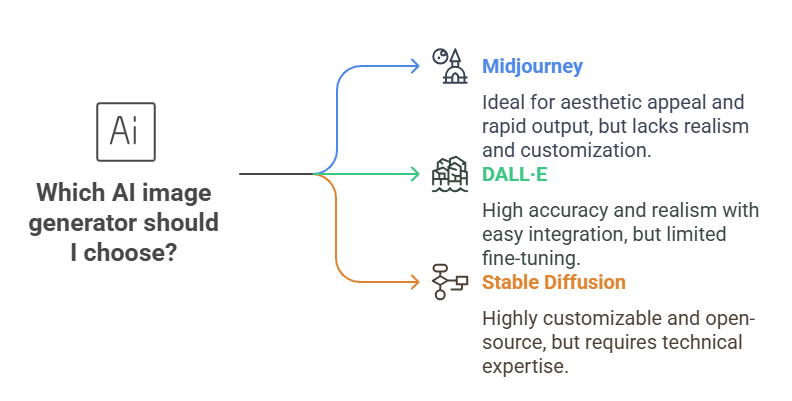
Midjourney Strengths:
- Unparalleled aesthetic appeal for fantasy, abstract, and stylized images.
- Ideal for concept art, book covers, and social media visuals.
- Rapid output with beautiful compositions requiring minimal prompt crafting.
Midjourney Weaknesses:
- Limited realism and accuracy for photorealistic tasks.
- Restricted to Discord, which some users find cumbersome.
- Less customizable compared to Stable Diffusion.
DALL·E Strengths:
- High accuracy and realism in generating detailed, coherent scenes.
- Integrated with familiar platforms (ChatGPT, Bing) for ease of use.
- Inpainting and editing features allow for interactive creative workflows.
DALL·E Weaknesses:
- Limited fine-tuning options.
- Style can sometimes feel generic or safe compared to Midjourney.
- Dependent on API quotas or subscriptions.
Stable Diffusion Strengths:
- Highly customizable with user control over almost every generation aspect.
- Open-source and free to use.
- Extensive community tools, plugins, and trained models available.
Stable Diffusion Weaknesses:
- Steeper learning curve, especially for non-technical users.
- Quality depends heavily on setup and prompt tuning.
- Slower setup and generation without proper hardware.
Understanding these trade-offs is key. A visual artist might prefer Midjourney for its ease and beauty, while a developer creating a custom app might lean toward Stable Diffusion. Meanwhile, marketers or bloggers needing quick visuals may find DALL·E the perfect mix of speed and reliability. Ultimately, choosing the right tool depends on the project goals and the user’s technical confidence.
Use Cases and Best Fit
Choosing the right AI image generator depends heavily on your specific use case and level of technical expertise. Each of the top tools—Midjourney, DALL·E, and Stable Diffusion—caters to different user profiles and scenarios.
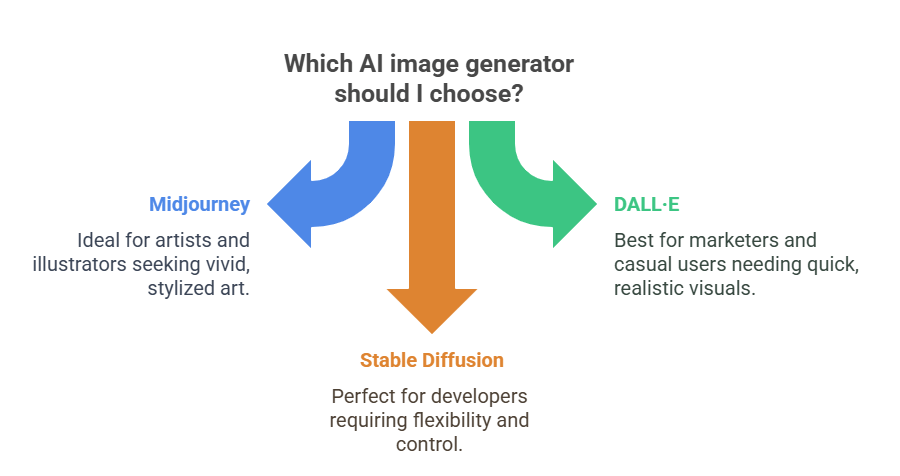
For Artists and Illustrators:
Midjourney is the go-to tool. Its ability to produce vivid, stylized, and emotionally evocative art makes it ideal for concept artists, illustrators, and fantasy content creators. It’s especially useful when aesthetic impact is more important than photorealistic accuracy. Users who work with book covers, music visuals, or storytelling media will find Midjourney’s artistic flair unmatched.
For Marketers and Content Creators:
DALL·E shines in this domain. With its web-friendly interface and strong balance of realism and creativity, it’s perfect for producing campaign visuals, blog images, product mockups, or educational illustrations. The inpainting feature is especially helpful for editing visuals to match branding needs or content revisions, making DALL·E an effective tool for fast-paced marketing teams.
For Developers and Technical Users:
Stable Diffusion stands out. Its open-source nature, plugin ecosystem, and ability to run locally make it perfect for integration into custom applications, research, and software development. Developers can tailor it to niche use cases, from generating game assets to creating interactive web apps. The learning curve is steep, but the rewards in flexibility and control are significant.
For Casual Users and Hobbyists:
DALL·E offers the easiest and most accessible entry point, especially for those already using platforms like ChatGPT. If you’re just starting with AI art and want quick, good-looking results without technical setup, DALL·E is your best bet. Midjourney also works well for casual creatives who enjoy exploring visually rich prompts in a social, Discord-based setting.
In essence, the best AI image generator is the one that aligns with your workflow. Artists may gravitate toward Midjourney’s aesthetics, businesses toward DALL·E’s practicality, and developers toward Stable Diffusion’s adaptability. Identifying your priorities—whether style, accuracy, control, or speed—will guide you to the right platform.
Real-World Use Cases
To better illustrate the strengths of each platform, let’s look at how Midjourney, DALL·E, and Stable Diffusion are applied in real-world creative workflows:
1. Midjourney in Entertainment and Concept Art
Game developers and film studios use Midjourney for early-stage concept development. Its ability to generate striking, imaginative environments and characters helps artists visualize scenes without spending weeks on sketches. For example, an indie game designer can quickly create mood boards and NPC designs using Midjourney prompts like “post-apocalyptic desert city at sunset, cinematic, ultra-detailed.”
2. DALL·E for Marketing and Education
Marketers often turn to DALL·E to generate visuals for blog posts, email campaigns, and presentations. Because of its photorealistic rendering and ease of editing, it’s ideal for commercial use. For instance, a digital marketer might prompt, “A modern kitchen with a smart refrigerator, bright lighting, minimalistic decor,” and get a polished image suitable for an ad. Educators turn to DALL·E to craft vivid diagrams, bring stories to life with beautiful illustrations, and design engaging classroom slides that capture students’ attention.
3. Stable Diffusion in App Development and Research
Stable Diffusion’s flexibility makes it ideal for integration into applications and experimental projects. Developers create AI art tools, avatar generators, and custom filters using fine-tuned models. Researchers in academia use Stable Diffusion to study generative models and explore visual creativity. A tech startup might train a custom model for anime-style characters and deploy it in a mobile app for users to create their own avatars.
These examples show how each tool excels in different domains—Midjourney in pure artistic creativity, DALL·E in accessible realism, and Stable Diffusion in innovation and experimentation.
As we move deeper into 2025, AI image generators have become indispensable tools for creatives across disciplines. Whether you’re crafting a fantasy world, designing sleek product visuals, or experimenting with interactive applications, there’s an AI art tool tailored to your needs.
- Choose Midjourney if you value artistic flair and want stunning, stylized imagery with minimal setup.
- Go with DALL·E if you need polished, realistic visuals and prefer a plug-and-play experience with editing tools.
- Opt for Stable Diffusion if you seek ultimate control, customization, and are comfortable diving into technical setups.
The best AI image generator isn’t a one-size-fits-all solution. It’s the one that best aligns with your creative vision, workflow, and technical skillset.
In a world where imagination is only a prompt away, these tools represent a new era of visual storytelling. Whether you’re a seasoned designer or a curious newcomer, now is the time to experiment, explore, and create.

